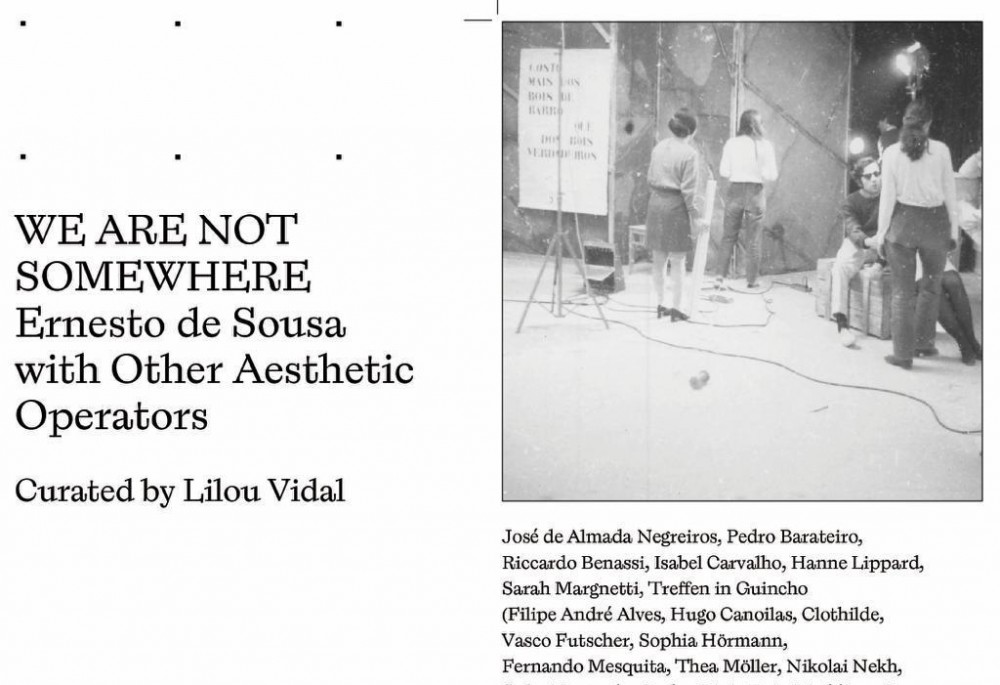
This book is launched on 3 November, at 18 hrs. at the bookshop
Paint It Black
Via Fratelli Calandra 6/A, 10123, Turin
On the occasion a performative lecture by Pedro Barateiro "Kissing someone in the Middle of the Crowd: Translating Ernesto de Sousa's "Orality, the Future of Art?" .
Lilou Vidal (editor and curator) and Achille Filipponi & Matteo Milaneschi (publishers) present the new
publication of ERNESTO DE SOUSA, EXERCISES OF POETIC COMMUNICATION WITH OTHER AESTHETIC OPERATORS, published by Axis Axis. On this occasion, a selection of works, ephemera from Ernesto de Sousa’s archive and work of art curated by Lilou Vidal will be displayed exclusively in store during one month.
ERNESTO DE SOUSA
EXERCISES OF POETIC COMMUNICATION WITH OTHER AESTHETIC OPERATORS
Ernesto de Sousa (1921–1988) was a major and multifaceted figure from the Portuguese avant-garde—artist, poet, critic, essayist, curator, editor, filmmaker, and a promoter of experimental ideas and artistic expressions.
Reflecting questions of hierarchy, authorship, and the complexity of framing or dividing within the multiple and
complementary practices of Ernesto de Sousa—whose motto “Your Body is My Body, My Body is Your Body” serves as a poetic manifesto—this publication explores the various aspects of his oeuvre (visual, poetical, and theoretical) and his outstanding inventiveness of concepts.
The volume brings together a selection of works, unpublished archives and their translations, and theoretical texts by Ernesto de Sousa, including the first complete translation in English of «Orality, the future of art?» (1968). Richly illustrated, the book reunites an introductory text by Lilou Vidal, two new essays by Paula Parente Pinto and by José Miranda Justo along with a text by Hugo Canoilas.
There was a time when bread was sacred; and in a general sense, all fabricated objects deserved the respect that resulted from (for the conscience of those who used them) concretely diving into their own motivations. Human gestures, like aesthetic objects, were inseparable from their relevant functions. Naturalism prompted us to look at natural and fabricated objects with a vision that was cosmic and indifferent at the same time. The objects, today, object. In the future, objects and gestures will perhaps clothe themselves once again in their lost dignity. The word love, a bit of bread, the letter A will stop being mortal accidents of daily life. Desacralized, they will once again be as decisive as the tiniest brushstroke the painter made on his canvas. And each of these brushstrokes will reveal the structure of the world. Life can then be compared to a vast work of art. Everything will be absolutely aesthetic.. Ernesto de Sousa
Published on the occasion of the eponymous exhibition of the centenary of his birth, Ernesto de Sousa, Exercises of Poetic Communication with Other Aesthetic Operators curated by Lilou Vidal at Galerias Municipais in Lisbon (27/11/2021 - 27/02/2022), this monographic book pays tribute to the kaleidoscopic vision of Ernesto de Sousa through an intergenerational, José de Almada Negreiros, Oficina Arara, Pedro Barateiro, Isabel Carvalho, Salomé Lamas, Hanne Lippard, Sarah Margnett, Franklin Vilas Boas Neto, Rosa Ramalho, Nils Alix-Tabeling, Nora Turato, Treffen in Guincho*, Ricardo Valentim.
Ernesto de Sousa (Lisbon, 1921-1988) was a prolific multidisciplinary artist and an avid promoter of synergies between various generations of artists from the first and second half of the 20th century. An advocate of free, experimental artistic expression, he devoted himself to the study, dissemination and practice of the arts. As a curator, critic and essayist, he was working in the areas of film, theatre and photography as well.
During the 1960s, he came into contact with the Fluxus movement and the European neo-avant-gardes, and befriended Robert Filliou, Wolf Vostell, among many others. These experiences played a decisive role in his reformulation of art as an experimental, participative “open work”, instances of which include Nós Não Estamos Algures (1969), a mixed media and theatrical experiment, the expanded film Almada, Um Nome de Guerra (1969-1972), Luiz Vaz 73, a mixed media piece co-authored with Jorge Peixinho and other collaborative works such as Encontro do Guincho (1969).
Until the 1980s, he organized courses, conferences and exhibitions about experimental film, video art, performance art and happenings, facilitating contacts between the Portuguese context and the international neo-avant-gardes.
By bringing Robert Filliou’s Anniversary of Art to the Círculo de Artes Plásticas de Coimbra in 1974, Ernesto de Sousa anticipated the Carnation Revolution and contradicted Portugal’s peripheral position in Europe. The exhibition Alternativa Zero (Galeria Nacional de Arte Moderna, Lisbon, 1977) synthesizes his project for the creation of a Portuguese avant-garde in aesthetic and ideological dialogue with its international counterparts. Alongside his curatorial, editorial and theoretical work produced during his lifetime, his production has been exhibited in solo and group exhibitions at international and Portuguese institutions and galleries. He was commissioner of the Portuguese representation at the Venice Biennale in 1980, 1982 and 1984.
On 14.04.2023. this book_catalogue has been launched at bookshop COMMERCE, in Milano.



